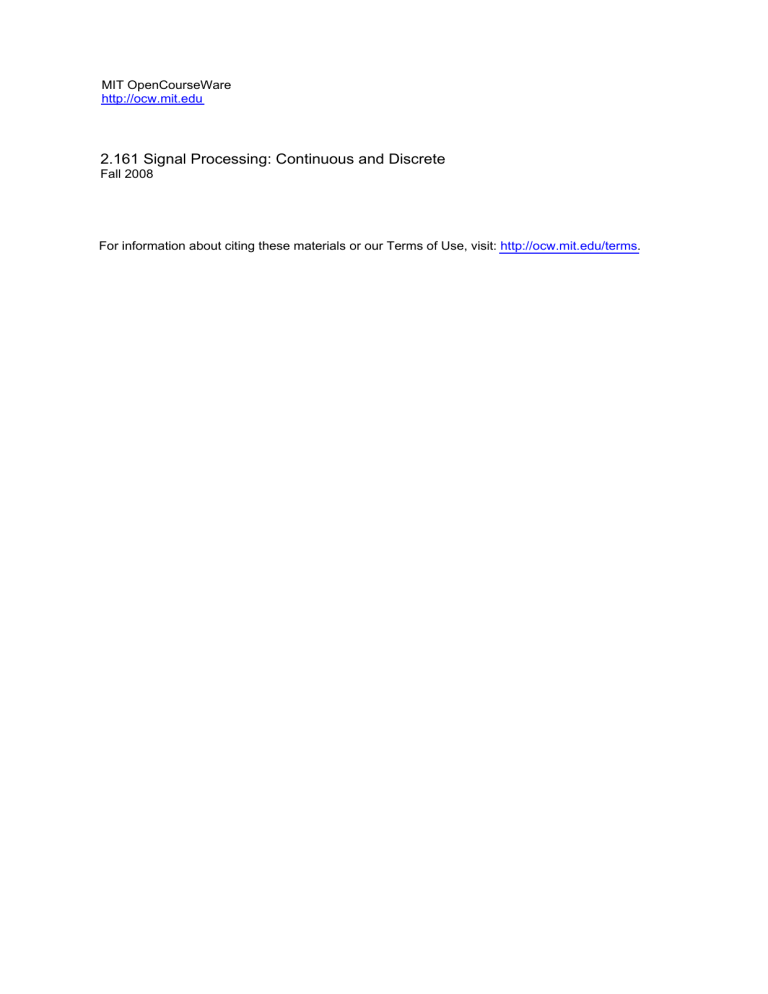
MIT OpenCourseWare
http://ocw.mit.edu
2.161 Signal Processing: Continuous and Discrete
Fall 2008
For information about citing these materials or our Terms of Use, visit: http://ocw.mit.edu/terms.
MASSACHUSETTS INSTITUTE OF TECHNOLOGY
DEPARTMENT OF MECHANICAL ENGINEERING
2.161 Signal Processing - Continuous and Discrete
Fall Term, 2007
Quiz #1 — October 18, 2007
Notes:
•
•
•
•
The quiz is open-book.
The time allowed is ninety minutes.
There are six problems, answer them all.
Partial credit will be given.
1
Problem 1: (15 points)
Show that to interpolate a value to the mid-point of a sampling interval in the sample set
{fn }, n = 0 . . . N − 1, where fn = f (nΔT ), the cardinal (Whittaker) reconstructor may be
written
−1
(−1)k
1 N�
f (nΔT + ΔT /2) =
fk
π k=0 (n − k + 1/2)
Problem 2: (20 points)
(a) Design (find the transfer function of) a unity-gain 3rd-order low-pass Butterworth analog
filter with a -3dB cut-off frequency of 10 rad/s.
(b) Make a pole-zero plot for your filter.
(c) Convert your design to a high-pass filter with the same cut-off frequency.
(d) If (do not do it) you were to convert your design to a band-pass filter, what would be
the order of the filter, how many zeros would be created, and where in the s-plane
would the zeros lie?
Problem 3: (15 points)
Many real-life signal processing problems involve waveforms containing echoes, or reverber­
ation. Consider a continuous-time linear filter with impulse response
h(t) = δ(t) + δ(t − τ )
Assume that the filter is excited with waveform f (t), and that the output is y(t)
(i) Show that the output contains an echo, that is
y(t) = f (t) + f (t − τ )
(ii) Find the frequency response H(jω) for the filter, and express it in terms of its magnitude
|H(jω)|, and phase � H(jω).
Hint:
�
�
1 + e−jθ = e−jθ/2 ejθ/2 + e−jθ/2
(iii) Assume f (t) = sin ωt. At what values of ω will the filter exhibit no steady-state output?
2
Problem 4: (20 points)
An AM (amplitude-modulated) radio signal fAM (t) is described by
fAM (t) = (1 + afaudio (t)) sin (ωc t)
fam(t)
where faudio (t) is the audio signal, sin (ωc t) is known as radio-frequency carrier signal (fc =
500 – 1600 kHz - the AM band), and a is a positive constant that determines the modulation
depth. (Note that we require |afaudio (t)| < 1 otherwise we have over-modulation.) the
following figure shows an AM signal with an “audio” waveform that is a simple low frequency
sinusoid. You can see how the audio signal “modulates” the amplitude of the rf signal.
1.5
1
0.5
t
0
−0.5
−1
−1.5
(a) Sketch the magnitude of the Fourier transform of fAM (t) when faudio (t) = 0.
(b) Let a = 0.5, and sketch the magnitude of the Fourier transform of fAM (t) when
faudio (t) = 0.5 cos(2π · 1000t) + 0.25 cos(2π · 2000t)
(Hint: There is no need to actually compute the FT. Consider expanding fAM (t), or
simply use properties of the FT.)
(c) Use your result from (b) to generalize, and sketch the magnitude spectrum of fAM (t)
when faudio (t) has a spectrum (again let a = 0.5):
F ( jw )
A
A
2
- w
u
- w
l
w
1
l
w
u
w
(d) If faudio has a bandwidth B = ωu − ωl , what is the bandwidth of a band-pass filter that
would be necessary to select the signal fAM (t) out of all the other AM radio stations?
3
Problem 5: (15 points)
The most commonly used (approximate) data reconstructor is the “zero-order hold” (ZOH)
which simply ”holds” the output value y(nΔT ) as a constant over the reconstruction interval:
y(t) = f (nΔT )
nΔT ≤ t < (n + 1)ΔT
where f (nΔT ) is the value of input at time t = nΔT . The output of the ZOH therefore
looks like a staircase function, with discrete jumps to a new value at each update time nΔT :
f(t)
t
ZOH recon.
f(t)
(a) Show that the ZOH can be represented as a linear filter with a pulse-like impulse response
h(t) = 1
= 0
0 ≤ t < ΔT
otherwise
Hint: Consider the sampled input data waveform f ∗ (t) as a weighted impulse train at
intervals ΔT ,
f ∗ (t) =
∞
�
f (nT )δ(t − nΔT ).
n=−∞
(b) Find and sketch the frequency response function H(jω) for the ZOH data reconstructor.
(c) Compare H(jω) with the frequency response of the ideal (cardinal) data reconstructor,
and comment on why the ZOH is a non-ideal reconstructor.
(d) The ZOH reconstruction (see the fig above) seems to be slightly delayed from f (t).
Determine the delay.
4
Problem 6: (15 points)
The significant frequency range of an analog signal extends to 10 kHz. Beyond 10 kHz the
signal spectrum rolls-off (attenuates) at a rate of 20 dB/decade.
The signal is to be sampled at a rate of 200 kHz. The aliased frequency components intro­
duced into the 10 kHz range of interest must be kept below -60 dB as compared to signal
components.
Suppose we use an analog low-pass pre-aliasing filter whose passband is flat over the 10 kHz
band, and then attenuates at a rate steep enough to satisfy the above sampling require­
ments. What is this attenuation rate in dB/decade? What would be the minimum order of
a low-pass filter to satisfy this condition?
Some useful/useless information:
θ
0
π/6
π/4
π/3
π/2
sin θ
0
1/2
√
√2/2
3/2
1
cos θ tan θ
1√
0√
3/2
3/3
√
2/2 1√
3
1/2
0
∞
x loge (x) log10 (x)
2
0.6931
0.3010
3
1.0986
0.4771
5
1.6094
0.6990
1.0000
10 2.3026
sin(a + b)
sin(a − b)
cos(a + b)
cos(a − b)
=
=
=
=
sin(a) cos(b) + cos(a) sin(b)
sin(a) cos(b) − cos(a) sin(b)
cos(a) cos(b) − cos(a) sin(b)
cos(a) cos(b) + cos(a) sin(b)
tan(a) + tan(b)
tan(a + b) =
1 − tan(a) tan(b)
tan(a) − tan(b)
tan(a − b) =
1 + tan(a) tan(b)
5


